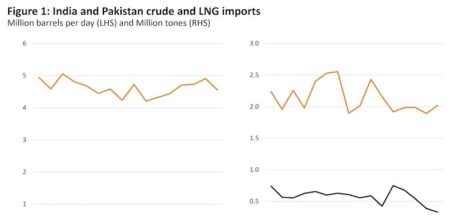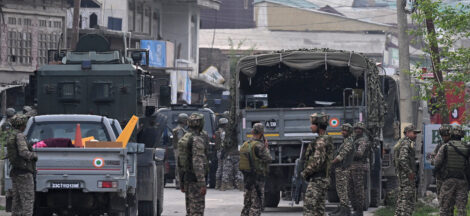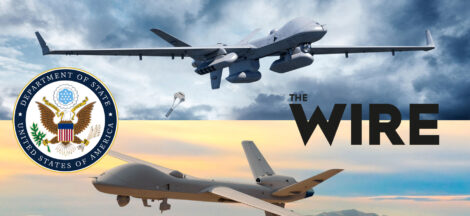 NEW DELHI: Agni-V, India’s most powerful missile with a strike range of over 5,000 kms, is set to get substantially higher destruction capabilities with plans to equip it with multiple warheads.
NEW DELHI: Agni-V, India’s most powerful missile with a strike range of over 5,000 kms, is set to get substantially higher destruction capabilities with plans to equip it with multiple warheads.
“We are working in this area. It will take time for us to develop but our work is on,” DRDO Chief Dr V K Saraswat told PTI when asked whether the agency is developing capabilities to produce a variant of Agni-V missile which can hit multiple targets.
Known as Multiple Independently Targeted Re-entry Vehicle (MIRV), the missile would be capable of carrying multiple warheads to destroy several targets.
Asked about the plans in that regard, he said, “Basic vehicle (missile) will remain the same. The first three stages will also remain the same and only the kill vehicle or the payload delivery system will need changes.”
Terming it as a “force multiplier”, the DRDO chief said, “If I am able to do force multiplication with this… where I was using four missiles, I may use only one missile. So it becomes a force multiplier given the damage potential.”
Such a capability exists only with a select few countries such as theUS,RussiaandChina.
Comparing Agni-V missile to the best in the world, Saraswat said, “It is a game changer missile… It has taken the missile technology to the highest level and matches with the best and the current world standards.”
MIRV missiles are equipped with small on-board rocket motors and computerised inertial guidance system which manoeuvres warheads to several different trajectories. On plans to develop missiles with 8000 km or even longer range, the DRDO chief said that will be done according to the evolving threat perception.
“Whenever the need arises, we will develop… Right now we feel, 5000 km-class of system meets our threat perception and threat requirement. But that does not mean that we will not develop a longer range missile. We will develop, but depending on the evolving threat perception,” Saraswat said.
He said that the successful test flight of Agni-V missile has given the country the necessary capability to design and develop missiles of longer ranges as well.
“As far as the capability of doing that kind of work (developing longer range missiles) is concerned, this missile (Agni-V) gives you the capability to build any missile of a range on the higher side,” he said.
Talking about the ongoing efforts to develop an array of tactical missiles, Saraswat said, “Work is going on a number of tactical missiles such as the long and medium-range surface-to-air missiles. The Mark-I version of Astra Long Range Air-to-Air Missile will be ready by 2015.”
He said that the long-range surface-to-air missile would be ready by 2014 while its medium-range version will take a year more. Astra Mark-I will be an 80-km range missile.
Saraswat refused to divulge the range of the Mark-II version of Astra missile.
On development of 150 to 180-km range Prahaar missile for the Army, the DRDO Chief said the project has now matured and demonstrations were given to the force.
“We have demonstrated it (Prahaar missile) to the Army. It is a fully developed missile including its launcher and cannister. It is ready and, if the Army makes a choice then we can take it from the present demonstration stage to the production stage,” Saraswat said.
AEROSPACE, DEFENCE POISED FOR GOOD RUN THIS YEAR TOO: PWC
BANGALORE: The global aerospace and defence industry will ride high in 2012 as it did last year, according to a report by industry consultancy PricewaterhouseCoopers.
Mergers and acquisitions in the sector are likely to continue this year too.
The national scene will be lifted mainly by government support and higher defence outlay.
The report, ‘Aerospace & Defence: 2011 year in review and 2012 forecast’, says a rosy-looking 2012 seems albeit tinged with rising costs and delayed deliveries.
“..Times are good for the A&D space. Many are [also] debating whether there’s a bubble. However, current backlog levels provide ample cushion between demand and production rates.”
It, however, cautions that, “although 2012 is off to a great start, the industry will continue to face rising production rates, raw materials shortages and late deliveries.”
On the domestic scene, Mr Dhiraj Mathur, Leader — Aerospace and Defence, PwCIndia, said, “The creation of the Indian aerospace supply chain and industrial base is gathering momentum. The drivers areIndia’s inherent competitiveness in manufacturing, IT and engineering services along with the (Government’s) proactive support and increased defence spending.”
Last year, commercial aerospace companies delivered a record 1,000-plus large aircraft. The top 100 A&D companies posted total revenue of $677 billion — a five per cent rise over 2010. Operating profits rose 2 per cent, at $60 billion.
Last year saw record A&D transactions, with 341 deals worth $43.7 billion conducted. In Asia and theUS, two re-engined single aisle aircraft models led the booking activity: the A320NEO and the 737MAX.
Mr Neil Hampson, Global Aerospace and Defence Leader, PwC, was quoted as saying that 2012 revenues could rise; but a poor supply chain may spoil the game.
“This year, we expect continued growth in commercial aerospace from strong and steady demand for global aviation and increased commercial aircraft production. Defence revenues should continue to trend modestly lower.” For defence contractors, export growth led to a record backlog of $327 billion in 2011.
These companies will face pressure to improve productivity, increase transparency and meet complex government regulations.
According to Mr Hampson, growth was to be read with backlogs at original equipment manufacturers.
IAF TO GET NEW TRAINER AIRCRAFT
NEW DELHI: Ending years of shortage for a basis training aircraft for young trainee pilots of the Indian Air Force, the Cabinet Committee on Security tonight cleared a major deal of $700 million (approximately Rs 2,900 crore) to buy 75 single-engined aircraft from Swiss company Pilatus.
The company will be selling its Pilatus PC-7 Mk-II turboprop aircraft in a twin-seat configuration which will allow a trainer to guide the rookie pilots. These are piston engined and fly at low speeds, allowing the rookie pilots to get a feel of flying as they graduate to the second level of training and then onwards to the fighters. Without the basic trainer, IAF rookie pilots were being sent straightaway to the second stage of training on the Kiran-Mk II aircraft.
The lack of a basic trainer since 2009 has seriously hit the pilot training programme. Although the Swiss company was shortlisted last year, a competing Korean aircraft maker Korean Aerospace Industries, which lost the contract, protested. It had pitched in with its KT-1 trainer.
IAF PROCURES FOUR SIMULATORS FOR AJT AIRCRAFT
The Indian Air Force has purchased four simulators for Hawk Advanced Jet Trainer (AJT) aircraft and more such machines have been contracted by the force for simulated training. The aim is to enhance the training curriculum of it’s rookie pilots.
Defence Minister A. K. Antony in a written reply to the Rajya Sabha said, “IAF has already procured four simulators for Hawk AJT aircraft. Further, eight simulators of IJT aircraft, have also been contracted for.”
Acquisition of more such trainer platforms is a part of the overall modernisation process of the armed forces. The new combat aircraft which the IAF is constantly acquiring will be manned by pilots using older fighter jets which are due to be phased out in a timely fashion.
The IAF is facing a shortage of pilots and the government has taken a number of steps to check that. Improvement of job profile of IAF pilots is a continuous process in view of the job specific requirements and operational necessity. Besides, the Short Service Commission for flying branch has been modified to make young men eligible for induction in the flying branch.
The Defence Minister also said that choppers are being purchased to replace the ageing Mi-8 aircraft of IAF’s Communication Squadron. Also a contract for procurement of AW-101 helicopters was signed with Agusta Westland in February 2010 to replace the ageing Mi-8 helicopters.
With more and more helicopters, planes and fighter jets set for induction in the coming years, the IAF is gearing up to hire more pilots and prepare the necessary infrastructure to support these sophisticated weapon systems.
ADDITIONAL $1.3 BILLION FOR DEFENCE COMMUNICATION NETWORK
A proposal is being processed for a Rs.5,236 crore ($1.3 billion) exclusive pan-India optical fibre cable (OFC) for the defence forces to enable them to vacate the radio waves they currently occupy, parliament was informed Wednesday.
The allocation is in addition to the Rs.8,098 crore ($1.8 billion) that was approved for the defence forces’ communication network in 2009, Defence Minister A.K. Antony said in a written reply in the Rajya Sabha.
The communications and information technology is processing the proposal for the OFC network to be laid over 60,000 km to provide connectivity for 129 army, 162 air force and 33 navy stations.
“The alternative network will be implemented to facilitate vacation of spectrum by the defence services,”Antonyadded.
PAK TESTS NUCLEAR-CAPABLE HATF-III BALLISTIC MISSILE
ISLAMABAD:Pakistanon Thursday successfully test-fired a nuclear-capable Hatf-III ballistic missile, with a range of 290 km.
As the test was conducted, a top Pakistani military official said the country had developed a “strong nuclear deterrence capability” and was fully capable of thwarting any aggression A statement issued by the military described the “training launch” of the short-range Hatf III or Ghaznavi missile as successful. “The launch was conducted at the conclusion of the annual field training exercise of the Army Strategic Force Command,” the statement said.
The military did not say where the exercise was conducted. It said the missile could carry nuclear and conventional warheads to a range of 290 km. The training exercise was aimed at “testing the operational readiness of a Strategic Missile Group,” the statement said.
Addressing troops in the exercise area, Joint Chiefs of Staff Committee Chairman Gen Khalid Shameem Wynne said the country had “developed a strong nuclear deterrence capability.” He said: “Pakistan’s Armed Forces are fully capable of safeguardingPakistan’s security against aggression.”
INDIA RAISING MORE OFFENSIVE CORPS: ANTONY
India is raising more offensive corps and taking other steps to gear up it’s preparedness along China border to meet the challenges, Indian Defence Minister A.K. Antony said as he pitched for a substantial hike in defence budget to meet this changing threat perception.
Terming the growing military ties betweenPakistanandChinaa ‘cause of concern’, he said the armed forces have been issued a new directive to change their strategy to meet the challenges. “Now we have given a new directive to our armed forces to meet the new challenges in context of the new threat perception faced by the country,” he said.
Antonysaid, “After analysis of the threat perception, we have found that the picture is problematic. We will need to have a second look at the defence budget. We have been given Rs 1.93 lakh crore this year but as per the estimated requirement of the armed forces, we would want Rs 2.39 lakh crore. We want Rs 45,716 crore more. I have asked the government to provide us more money.” The minister was replying to a discussion on the performance of his Ministry in the Rajya Sabha.
On steps taken by the government to strengthen defence capabilities,Antonysaid “Under 12th Defence Plan, we have sent a proposal to Finance Ministry to raise an offensive corps with two special divisions and it is in final stages.
“The force-level has been increased substantially.” He said the government had earlier approved raising of two mountain divisions along with a special forces battalion, an artillery brigade and an armoured regiment for deployment in the northeast sector.
Up Next:
China And Russia Arming Bangladesh


